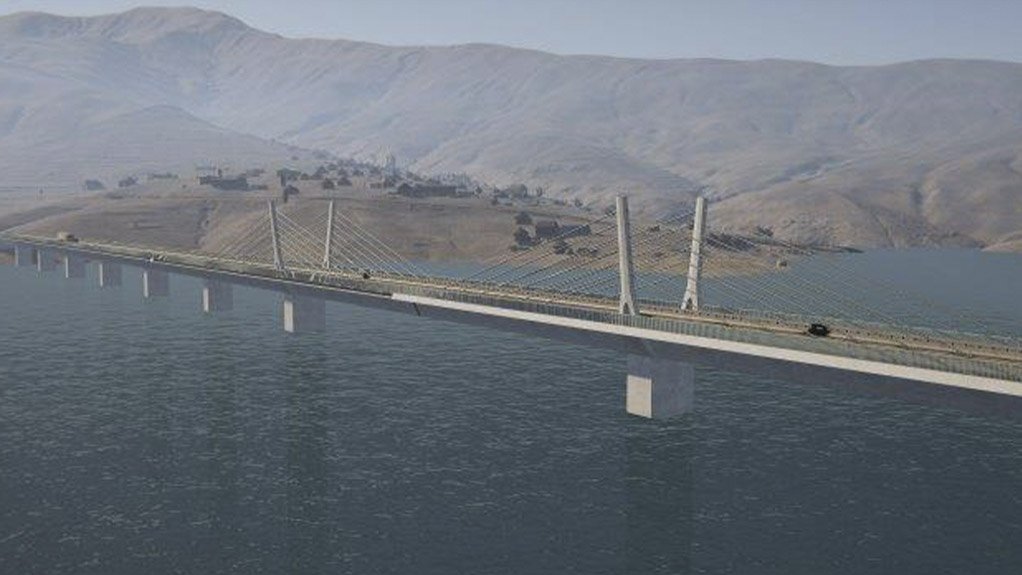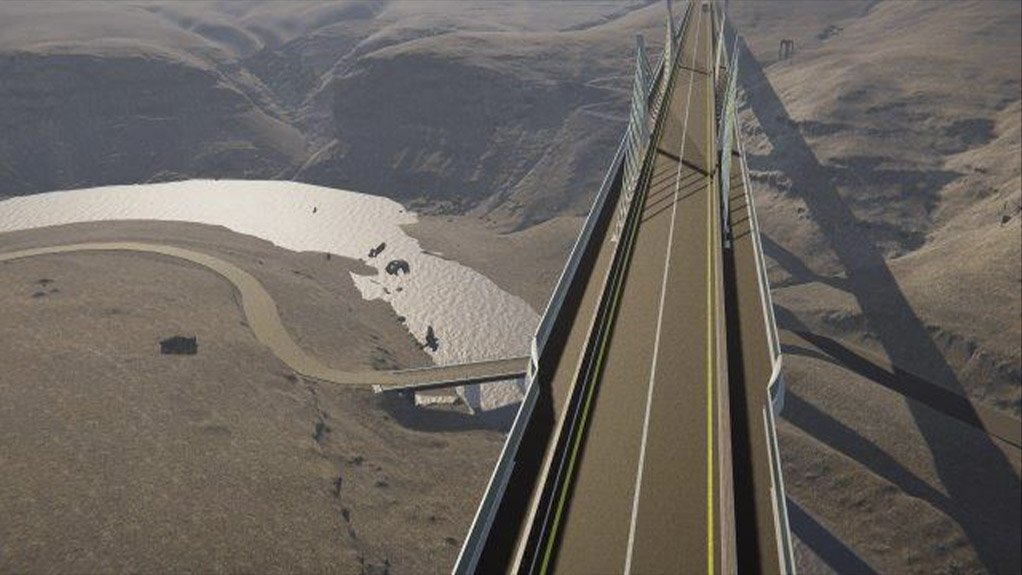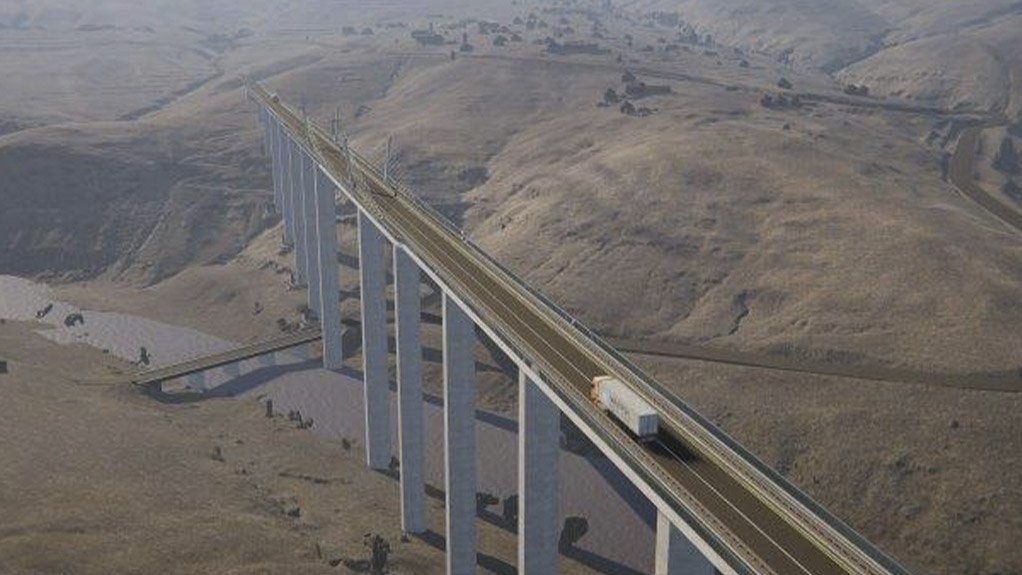Zutari provides design and site supervision services for three major bridges in LHWP Phase II
This article has been supplied as a media statement and is not written by Creamer Media. It may be available only for a limited time on this website.
Leading consulting engineering and infrastructure advisory firm Zutari has been awarded a contract by the Lesotho Highlands Development Authority (LHDA) for design and site supervision services for the Senqu Bridge, the Mabunyaneng Bridge and the Khubelu Bridge, all part of the Lesotho Highlands Water Project (LHWP) Phase II. As part of a joint venture, Zutari is also involved with the Polihali Diversion Tunnels project and the Polihali Transfer Tunnel project, explains Natie Wilson, Zutari Technical Director, Transportation Services.
The Senqu, Mabunyaneng and Khubelu bridges are situated on the A1 national route, which is the main access road between Oxbow and Mokhokong. The impoundment of the Polihali Dam will result in the flooding of the existing bridges and road in these locations, and access to Mokhotlong will be lost unless the bridges are reconstructed at higher levels. The project is therefore located in the mountainous Lesotho Highlands, where minimum temperatures of up to -20˚C have been recorded. Hence the remote nature of the site, coupled with extreme weather conditions, pose a significant logistical challenge.
An elaborate preliminary design process was followed to determine the most feasible alternatives that would meet all the required constraints that influence these bridges. One of the most important constraints considered is the influence of the structures on the local communities that will be affected by the dam development.
Senqu Bridge consists of an 825-m-long, incrementally-launched box girder deck and an extradosed stay cable portion to allow for a 100 m centre span. One of the main construction constraints for this bridge is that construction must be completed in time for the impoundment of the dam. The construction time could be reduced by constructing the bridge from both sides. In addition, flooding of the Senqu River might delay construction when a pier is constructed in the centre of the river.
In order to accommodate these two constraints in the design, the normal practice of a temporary steel launching nose was removed and replaced by supporting the front portion of the deck by means of cable stays. This pier in the centre of the river was removed, resulting in a 100 m centre span above the Senqu River. This span would be formed by stitching together the two decks launched from either side of the river, meeting in the centre of the 100 m span. The substructure consists of 90-m-high piers founded on spread footings.
The Mabunyaneng Bridge (120 m) and Khubelu Bridge (270 m) superstructures consist of variable-depth prefabricated post-tensioned concrete beams, with in-situ cast reinforced concrete top slabs. The substructures will consist of reinforced concrete wall-type piers and closed-wall abutments with wing walls. The design of these two bridges was carried out by Leporogo Specialist Engineers.
Three-dimensional models of the bridges were created in Revit, and the normal standard tender drawings, as required by the construction industry, were generated from these models. The 3D models were used to better visualise the structure and construction process for the client and prospective tenderers. For this purpose, an interactive model of the bridge was created to allow the client to visualise the structure in its surroundings before and after dam impoundment.
A construction sequencing video was also prepared to demonstrate the intended construction process to the client and potential tenderers. In addition, drones were used to create videos and surveys of the construction site, which have a number of purposes. These are to provide the client with a record of the sites before construction, give the design team a better view of the construction area, and also show the sites to prospective tenderers. All of these innovations were particularly relevant during the Covid-19 pandemic so as to not delay the tender process, but still providing prospective tenders with the required site and construction information without a site visit.
An innovative virtual tender briefing was carried out in March 2021 for Senqu Bridge, with the tender closing in July 2021. It is anticipated that ground should be broken in Q2 2022. The duration of construction is estimated at three years for Senqu Bridge and two years for Mabunyaneng Bridge and Khubelu Bridge respectively.
During construction supervision, Zutari will provide a range of staff, many of whom will relocate to site for the duration of the project. All prevailing Covid-19 regulations will be adhered to, and a site-specific health and safety management plan will be compiled by the successful tenderer and reviewed by Zutari prior to commencement of construction.
Local labour requirements are part and parcel of the tender philosophy and will be coordinated via the LHWP implementing authority, Lesotho Highlands Development Authority (LHDA). During the tender design stage, skills development was overseen by the Zutari team, with senior staff members working closely with and imparting their knowledge and experience to junior staff members. In addition, two young professionals were seconded by LHDA to Zutari. These individuals were fully integrated into the Zutari design team and hence gained invaluable experience.
Key members of the Zutari team are Chief Design Engineer and Senior Bridge Design Engineer Johan Kotzé, Senior Engineering Geologist Salona Naidoo, Senior Road Design Engineer Francois van Reenen, Environmental Specialist Tau Mahlelebe from White Life Consultants and Occupational Health and Safety Specialist Evert de Vries.
Zutari’s bridge team has a long history of successful bridge designs, including the Siphofaneni River Bridge, a 375 m incrementally launched box girder bridge in 2013 in Eswatini, the Olifants River Bridge, a 166 m long bridge with a 93 m arch, also in 2013 and the Malibamatso Bridge, a 465-m-long incrementally-launched post-tensioned girder bridge in 1988 in Lesotho.
“LHDA, through its Project Management Unit, has been instrumental in making a success of the project thus far. Although it operates within a highly regulated environment due to the multinational and multidisciplinary nature of the project and overall programme, it has been visionary in the way it has approached the execution of the contract, and in particular their relationship with all stakeholders,” concludes Wilson.
Comments
Announcements
What's On
Subscribe to improve your user experience...
Option 1 (equivalent of R125 a month):
Receive a weekly copy of Creamer Media's Engineering News & Mining Weekly magazine
(print copy for those in South Africa and e-magazine for those outside of South Africa)
Receive daily email newsletters
Access to full search results
Access archive of magazine back copies
Access to Projects in Progress
Access to ONE Research Report of your choice in PDF format
Option 2 (equivalent of R375 a month):
All benefits from Option 1
PLUS
Access to Creamer Media's Research Channel Africa for ALL Research Reports, in PDF format, on various industrial and mining sectors
including Electricity; Water; Energy Transition; Hydrogen; Roads, Rail and Ports; Coal; Gold; Platinum; Battery Metals; etc.
Already a subscriber?
Forgotten your password?
Receive weekly copy of Creamer Media's Engineering News & Mining Weekly magazine (print copy for those in South Africa and e-magazine for those outside of South Africa)
➕
Recieve daily email newsletters
➕
Access to full search results
➕
Access archive of magazine back copies
➕
Access to Projects in Progress
➕
Access to ONE Research Report of your choice in PDF format
RESEARCH CHANNEL AFRICA
R4500 (equivalent of R375 a month)
SUBSCRIBEAll benefits from Option 1
➕
Access to Creamer Media's Research Channel Africa for ALL Research Reports on various industrial and mining sectors, in PDF format, including on:
Electricity
➕
Water
➕
Energy Transition
➕
Hydrogen
➕
Roads, Rail and Ports
➕
Coal
➕
Gold
➕
Platinum
➕
Battery Metals
➕
etc.
Receive all benefits from Option 1 or Option 2 delivered to numerous people at your company
➕
Multiple User names and Passwords for simultaneous log-ins
➕
Intranet integration access to all in your organisation



























